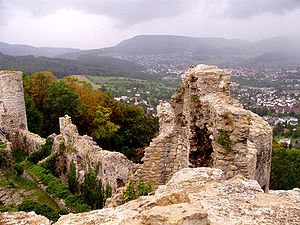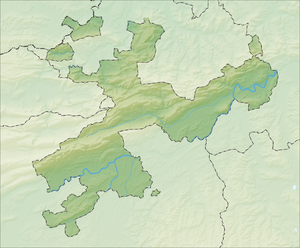Dorneck ruins
| Dorneck ruins | ||
|---|---|---|
|
View of the Birseck from the Dorneck ruins |
||
| Creation time : | around 1050 | |
| Castle type : | Hilltop castle | |
| Conservation status: | ruin | |
| Place: | Dornach | |
| Geographical location | 47 ° 28 '48 " N , 7 ° 37' 41" E | |
| Height: | 490 m above sea level M. | |
|
|
||
The Dorneck Castle is the ruins of a medieval fortress ( hill fort ) near Dornach in canton Solothurn in Switzerland .
location
The ruin is located in Dornach in Solothurn in north-west Switzerland . It stands at 490 m above sea level. M. on a large rock ridge east of the village of Dornach, between the valley floor of the Birs and the slope of the Gempen plateau . The choice of this location with its steep slopes makes access from the east, south and west difficult: accordingly, access to the complex was and is only from the north, from the direction of the castle courtyard.
The large and widely visible fortress is easy to reach for hikers from all directions via well-developed and signposted hiking trails. The approach can be from the center of the village of Dornach (signpost) and is easily possible with a car. At the same time as the castle, the castle courtyard (now a restaurant), the economic property of the Dorneck Fortress, which was created as part of the complex, can be visited. There is a view of the region from both the ruins and the castle courtyard.
investment
In the north of the facility, a square was leveled on which economic buildings were probably located. It can also be assumed that building material for the construction of the fortress was obtained with the leveling of this place. The castle itself is around 100 meters long and 50 meters wide, which can be considered very large for this region.
|
The castle is accessed via the outer gate (2, see floor plan) and the gate ditch carved into the rock with a drawbridge in front of it . But that only is kennel achieved from (5) of the through the second gate (4) with gatehouse of the outer court bailey could be achieved. The small bulwark (6) is attached to this outer courtyard as part of the outer bailey . The core of the fortress can only be reached through the inner gate (11). The stone cannon balls that decorate the inner gate today come from the rubble of the fortress. Several parts of the building are arranged around a central courtyard (20): residential building (13), kitchen (15), chapel (17) and various towers. The whole complex is dominated by the large bulwark (7). This stands on the topmost rock spur, is massive (without rooms) and was intended for large guns. Today the large bulwark can be reached from the central courtyard via an iron staircase and offers a wonderful view.
history
Although Dorneck Castle is only mentioned in writing from the middle of the 14th century, archaeological finds show that the fortress existed from around the middle of the 11th century. At that time, this area belonged to the Free von Pfeffingen , who can probably be considered the founder of the castle. The fortress then passed to the Counts of Suckers through family ties and then to the Counts of Thierstein around 1200. The castle was damaged in the Basel earthquake in 1356, but was quickly repaired and even expanded. In 1360 the Dorneck was sold to Duke Rudolf IV of Habsburg . The Thiersteiners got the fortress back from Rudolf immediately as a fiefdom: In the legal system of the time ( feudal system ), this was a common procedure in order to place themselves under the protection of a more powerful patron. Half of the village Dornach and Gempen belonged to the castle : As was customary at that time, the inhabitants of the villages and the country belonged to the goods complex and were traded with it. This fiefdom was also sold to Austria in 1384, although half of the village of Dornach was still owned by Thierstein.
After the defeat in the Battle of Sempach , the Habsburgs had to bear a gigantic debt burden and were forced to pledge several goods in order to restore their finances. The castle was taken as a pledge by the Basel citizen Henmann von Efringen in 1394 , although Austria reserved the right to open it so that the fortress could be used in the event of war. In 1462 the Efringers took over half of the village of Dornach. This family also got into financial difficulties in the 15th century, had internal disputes and had to mortgage Dorneck to Konrad von Hallwyl . In 1485 the city of Solothurn - whose policy was based on expansion in the north - bought the castle. At that time, the fortress was already in poor condition, because the rights (taxes and duties, jurisdiction, etc.) that were attached to the castle - even as a ruin - were often more interesting for the buyer than the building itself Nevertheless, in 1499 the castle garrison succeeded with luck in the course of the Swabian War at the battle of Dornach against an attack by the Imperial German troops, because the federal troops arrived in time and defeated the enemy.
In the same year repairs and expansion work began, and over the next 300 years the castle was expanded into a fortress. The Dorneck is one of the few medieval castles in which significant financial resources have been invested in order to adapt them to warfare using artillery. Around sixty Solothurn bailiffs resided one after the other on Dorneck. In the Thirty Years War , the fortress thanks to strong forces and good armament remained unmolested. When the French invaded in 1798, the castle was damaged by heavy artillery fire and then captured. In the 19th century the facility was used as a quarry . In 1902 the citizens of Dornach, who owned the ruins, donated the remains to the Canton of Solothurn, which then had them cleaned and preserved until 1906. The Solothurn Monument Preservation has been looking after the complex since 1970.
The castle ruins are freely accessible and with the keep , palas and tower from the 13th century, kennel , flank tower and chapel tower from 1500, its large and small bulwark , the powder tower from 1543, the curtain wall and various buildings still show their former mighty extent.
literature
- Werner Meyer : Castles from A to Z - Burgenlexikon der Regio . Published by the Castle Friends of both Basels on the occasion of their 50th anniversary. Klingental printing works, Basel 1981, pp. 196–199.
- Bruno Amiet : The castles and palaces of the canton Solothurn Birkhäuser, Basel 1930.
- Emil Erdin, Werner Meyer, Laslo Irmes: Castles of Switzerland Volume 7, Silva, Zurich 1981.
See also
Web links
- Anna C. Fridrich: Dorneck. In: Historical Lexicon of Switzerland .
- Castle world: Dorneck Castle
- Dorneck ruins (French)




